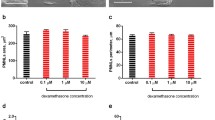Abstract
Oxygen radicals have been shown to alter granulocyte function by injury to the cell membrane or cytoskeleton. We have investigated the effect of such injury on the aggregation of granulocytes upon C5a or PMA stimulation. Granulocyte aggregation was not altered in the presence of the oxygen radical scavengers SOD, catalase, mannitol, or benzoate. To test whether oxygen radicals were required for aggregation, we evaluated three patients with chronic granulomatous disease of childhood. The response of PMNs from these patients was no different from controls. Hydrocortisone, an inhibitor of both granulocyte aggregation and oxygen radical generation, was then studied to decide whether its impairment of radical production contributed to its effect on aggregation. Five times the concentration of hydrocortisone needed to inhibit radical generation was required to impair aggregation by 50%. In addition, hydrocortisone was able to impair the aggregation of the PMNs of a patient with chronic granulomatous disease. These data suggest that oxidative injury to the cell membrane or cytoskeleton does not significantly contribute to the aggregation of granulocytes. In addition, inhibitors of aggregation, such as hydrocortisone, work through mechanisms other than by scavenging radicals.
Similar content being viewed by others
References
O'flaherty, J. T., andP. A. Ward. 1979. Chemotactic factors and the neutrophil.Semin. Hematol. 16:163–174.
O'flaherty, J. T., andP. A. Ward. 1978. Leukocyte aggregation induced by chemotactic factors.Inflammation 3:177–194.
Hammerschmidt, D. E., L. J. Weaver, L. D. Hudson, P. R. Craddock, andH. S. Jacob. 1980. Association of complement activation and elevated plasma C5a with adult respiratory distress syndrome.Lancet 1:947–949.
O'flaherty, J. T., D. L. Kreutzer, H. J. Showell, andP. A. Ward. 1977. Influence of inhibitors of cellular function on chemotactic factor induced neutrophil aggregation.J. Immunol.119:1751–1756.
Craddock, P. R., J. G. White, D. J. Weisdorf, andD. E. Hammerschmidt. 1980. Digital integration of granulocyte aggregation responses.Inflammation 4:381–395.
Oseas, R., H. Yang, R. L. Baehner, andL. A. Boxer. 1981. Lactoferrin: A promoter of polymorphonuclear leukocyte adhesiveness.Blood 57:939–945.
O'flaherty, J. T., H. J. Showell, E. L. Becker, andP. A. Ward. 1979. Neutrophil aggregation and degranulation. Effects of arachidonic acid.Am. J. Pathol.95:433–444.
Baehner, R. L., L. A. Boxer, J. M. Allen, andJ. Davis. 1977. Auto-oxidation as a basis for altered function by polymorphonuclear leukocytes.Blood 50:327–335.
Boxer, L. A., S. B. Richardson, andR. L. Baehner. 1978. Effects of surface active agents on neutrophil receptors.Infect. Immun. 21:28–33.
Sagone, A. L., Jr., M. A. J. Rodgers, andE. L. Powers. 1981. Effect of anti-inflammatory agents on the hydroxyl radical production of zymosan stimulated human granulocytes.In Oxygen and Oxy-Radicals in Chemistry and Biology. Academic Press, New York. 719–724.
Ambruso, D. R., andR. B. Johnston, Jr. 1980. Lactoferrin enhances hydroxyl radical production by a paniculate fraction of neutrophils.Clin. Res. 28:491.
Segal, M., R. H. Fertel, E. H. Kraut, andA. L. Sagone, Jr. 1981. The role of reactive oxygen species in thromboxane B2 generation by human polymorpnonuclear leukocytes.Blood 58 (Suppl. 1):77.
Mendelson, D. S., E. N. Metz, andA. L. Sagone, Jr. 1977. Effect of phagocytosis on the reduced soluble sulfhydryl content of human granulocytes.Blood 50:1023–1030.
Craddock, P. R., D. E. Hammerschmidt, J. G. White, A. P. Dalmasso, andH. S. Jacob. 1977. Complement (C5a) induced granulocyte aggregation in vitro. A possible mechanism of complement mediated leukostasis and leucopenia.J. Clin. Invest. 60:260–264.
Hogg, R., andE. Tanis. 1977. Probability and Statistical Inference. Macmilian, New York.
Craddock, P. R., H. S. Jacob, andJ. G. White. 1978. The potentiation of complement (C5a) induced granulocyte aggregation by cytochalasin B.J. Lab. Clin. Med. 91:490–499.
Mccall, C. E., J. T. O'flaherty, C. Cousart, D. A. Bass, andL. R. Dechatelet. 1980. Phorbol myristate acetate causes neutropenia, thrombocytopenia and pathologic findings in the lung.Clin. Res. 28:559A.
Weiss, S. JK., andA. L. Sagone, Jr. 1979. The effect of oxidant stress on diamide treated human granulocytes.Biochim. Biophys. Acta 585:620–629.
Author information
Authors and Affiliations
Rights and permissions
About this article
Cite this article
Kraut, E.H., Segal, M. & Sagone, A.L. Evaluation of the role of oxygen radicals in polymorphonuclear leukocyte aggregation. Inflammation 6, 161–167 (1982). https://doi.org/10.1007/BF00916240
Issue Date:
DOI: https://doi.org/10.1007/BF00916240



